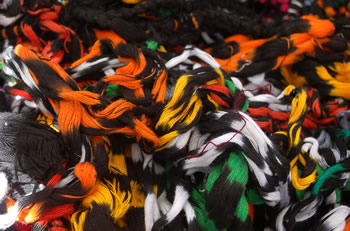Textiles
Ever since I can remember I have loved color, texture, and beautiful handmade things. This passion started innocently enough with an early love of beautiful stationary and has taken the form of sewing, knitting, paper making and even several years as a profession paper marbler. I have done my share of hording beautiful fabric, coveting skeins of hand spun yarn and filling flat files with exquisite handmade paper.
But my abiding obsession is with handmade fabric: woven, stitched, dyed—I love it all.
On this page you will find photographs and links to resources that celebrate handmade fabric from all over the world. I am especially interested in learning about and sharing traditions that are dying out (no pun intended) or endangered or very ancient fabric making traditions that, against all odds are alive today and are made in the same way they have been for hundreds of years.
Ikat is an ancient way of creating a design on woven cloth. It is found in many part of the world including Central and South America, East Asia, notably Indonesia, and in India. This highly skilled type of weaving requires the artist/craftsperson to die the threads of the warp (single ikat) and/ or the warp and weft (double ikat) in a resist process, and use the pre-died thread to create a design.
Depending on where the ikat fabric is made you will find a great variety of designs and colors. Above are some designs from Guatemala and to the right are ikat designs from Indonesia.

Kantha embroidery is made by women in the North Eastern state of Bengal in India. It is an enduring art form created out of the simplest of embroidery stitches—the running stich. Kantha has humble roots. The word kontha means rags in Sanskrit. Traditionally poor, rural women would take discarded fabric and rags and stich them together to make blankets. Designs were passed down from mother to daughter and would symbolize relationships, hopes for fertility and marriage.
Today Kantha embroidery is found on saris, blankets and scarves in many designs, colors and patterns.










